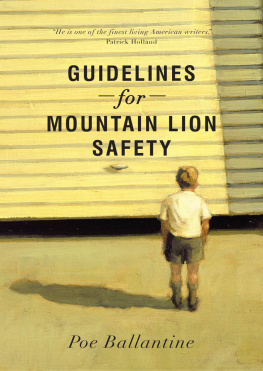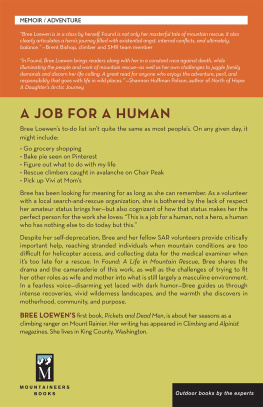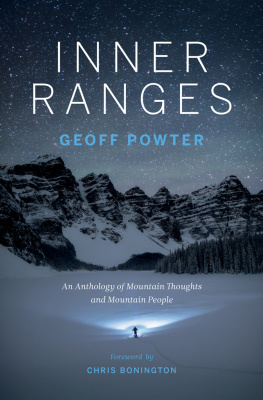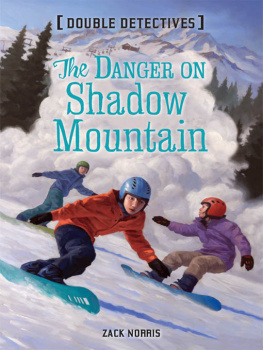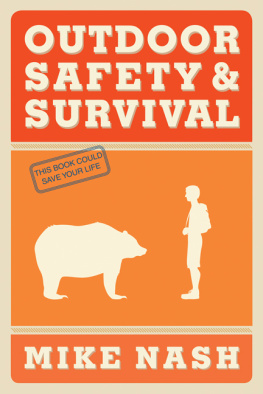HAZARDS IN THE HIGHLANDS
The chilly climate and thin air of the mountain biome adds an extra layer of danger to mishaps that occur at high altitudes. Shocking and triumphant true accounts of railroad wrecks, plane and helicopter crashes, and mountaineers who nearly met their maker are featured in this collection. Fact boxes about mountain safety and essential gear to take on your own outdoor trek are included.
About the Author
Glenn Scherer is an author and journalist. He enjoys educating others through his books in hopes that well-informed readers will help find solutions to our environmental problems.
Mount Everest in the Asian Himalayas straddles Nepal and Tibet. It is 29,035 feet tall (8,850 meters). As of 2007, there were 3,684 completed ascents, and 208 climbers died, a fatality rate of 5.6 percent.
Annapurna, in the Himalayas, is the tenth highest peak in the world at 26,545 feet (8,091 meters). By 2007 only 153 people had conquered Annapurna, but 61 climbers had died there, a fatality rate of 39 percent.
Nanga Parbat, Earths ninth highest peak at 26,660 feet (8,125 meters), has been summited by 287 climbers, but 64 climbers have died, a fatality rate of 28 percent. Another dangerous peak is K2, the second highest mountain in the world, at 28,250 feet (8,611 meters). With 302 successful climbs and 77 fatalities, it has a 25 percent fatality rate.
Denali (Mt. McKinley) in Alaska is 20,320 feet tall (6,193 meters). It has claimed nearly one hundred lives, though with thousands of climbers annually, the fatality rate is relatively low.
Mount Washington in New Hampshire is only 6,288 feet (1,916 meters) tall. But its locationwhere three storm tracks meetproduces horrific winds and weather. One of the highest wind gusts ever (231 miles per hour), was recorded on Mt. Washington. More than a hundred climbers have died there. Small crosses mark the spots where they lost their lives.
Oregons Mount Hood, 11,239 feet tall (3,426 meters), is the second most climbed mountain in the world. About 10,000 climbers a year try the ascent, and 130 have died since record keeping began over a hundred years ago.
The 1910 Great Northern Railway avalanche in Washington States Cascade Mountains was the deadliest in the nation, killing at least ninety-six people.
On January 10, 1962, an avalanche in Ranrahirca, in the Peruvian Andes, killed 4,000 people. On May 30, 1970, a bigger avalanche happened in the same place. An earthquake triggered the release of a massive wall of ice on Mount Huascaran, 22,205 feet tall (6,768 meters). Within three minutes the avalanche slid 6 miles (10 kilometers) down a glacier, destroying Ranrahirca and the town of Yungay. About 20,000 people died, with just 400 survivors.
By 1910 it must have seemed to most people that machines had beaten nature. The Wright brothers plane had conquered the skies. Barney Oldfields racecar was about to top speeds of 130 miles per hour. And trips that took months by covered wagon could be made in just days by railroad.
Unfortunately, the nations railway builders took some big risks to conquer the Western mountains. Their trains often climbed over high alpine passes. The tracks ran along cliffs where the risk of snow slides was high.
Still, no one guessed what lay ahead when two Great Northern Railway trains headed for the Pacific Coast on February 23, 1910. About 125 passengers and crew chugged east on Spokane Local Passenger Train No. 25 and Fast Mail Train No. 27.
All went well until the trains entered the Cascade Mountains. On the east side of the Cascade Tunnel, a blizzard closed the tracks completely. Both trains were stopped at the little railroad town of Wellington, Washington. There they sat on the edge of a steep ravine beneath Windy Mountain.
At first, no one worried, but the delay grew longer and longer. The powerful steam-driven rotary snowplows that normally kept the tracks clear were no match for the fierce winter snows.
The bored passengers and crew played cards and read books. They wrote letters that they couldnt mail. They trudged each day to the local hotel to eat their meals. Still the snow fell. The trains were slowly buried under the drifts. Some passengers began to worry about the chance of an avalanche, also called a snow slide.
The avalanche risk was greatened by the fact that Windy Mountain had recently been logged and burned by forest fires. That meant fewer trees to hold the snow in place.
On February 26, the blizzard knocked down the telegraph wires. Now the trains and the town of Wellington were cut off from the outside world.
Then the weather warmed. The snowstorm that had kept the trains trapped almost a week now turned to rain. There was fierce thunder and lightning. Still, few guessed at the danger they were in.
Then on the night of March 1, at 1:42 A.M. , the weight of the rain finally caused the huge drifts of snow that hung above the trains to let loose. An avalanche raged down the side of Windy Mountain.
It seemed as if the world were coming to an end, said one Wellington townsperson. I saw the whole side of the mountain coming down, tearing up everything in its way.
The avalanche carried all in its path, including snow, ice, trees, and rocks. In seconds both trains were engulfed. They were knocked off the tracks and into the ravine. The train engines tumbled down the slope. The wooden passenger cars flew through the air. They splintered and came apart like shattering eggshells. Metal and wooden fragments impaled people and cut them to pieces. People shrieked in pain and confusion as they fell through the darkness.
Passengers and crew fell all the way to Tye Creek, deep in the ravine. Some were buried under 40 feet of snow. Their bodies wouldnt be found until spring.
There were roughly 125 people sleeping on the trains that night. To the railroad workers who lived in Wellington, it seemed certain that all of those people were dead.
Still, the townspeople came out into the driving rain and darkness to help. Some, without thinking of their own safety, began climbing down the ravine to offer any aid they could to anyone lucky enough to have survived.
Amazingly, some passengers and crew were still alive. Some buried amid the snow and wreckage swam up through the drifts and darkness to save themselves. On the mail train, a buried conductor dug himself out. Then, in a flash of lightning, he saw a hand sticking out of the snow. Digging in a hurry, the conductor was able to free another crewman from his tomb of snow.
Two Wellington men, Charles Andrews and Bob Miles, went down into the canyon. They found a man and woman still alive, buried up to their necks in snow. The two men dug with bare hands to free the couple. But the snow was packed as tight as stone. The men ran to get shovels, but when they returned, they found the couple dead.
One rescuer, William Flannery, found an injured passenger. He lifted the hurt man onto his back. But a new avalanche hit both of them. Flannery himself was buried in snow, dug himself out, and then stumbled into Tye Creek. Unable to find the man he had been trying to save, Flannery instead helped rescue Duncan Tegtmeier, the engineer of one of the doomed trains.
A seven-year-old boy, Raymond Starrett, was found with a jagged 30-inch wooden fragment stuck in his forehead. A rescuernot a doctoroperated on the boy, removing the inch-wide splinter with a shaving razor. Amazingly, the child lived.
Perhaps the most astounding rescue of all was of an eighteen-month-old infant. The baby, named Varden Gray, survived the night buried in snow. Not only did Varden live; so did his parents, even though they had been buried all night nearby.



